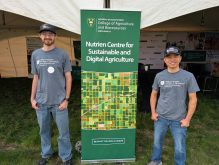Dry conditions in crops northeast of Calgary and south to the Little Bow River suggest average to below average crop yields unless rain is received soon.
South of that region, where irrigation is available, crops appear much heavier.
Such was revealed yesterday during the first leg of a crop tour organized by the CWB that will see tours in Alberta, Saskatchewan and Manitoba culminate in an information session in Regina Thursday.
Justin Daniels, director of commodity risk management for CWB, said canola and wheat fields in the region are highly variable, with different rates of maturity that speak of a cool, wet spring and later than usual seeding.
Read Also

Field-by-field mapping could improve yield, productivity predictions
University of Saskatchewan researchers are using field border mapping to collect data on field variability, including problematic weeds, and to predict things like yields.
Canola ranged from full bloom to podding, and some wheat crops are still in flower.
The crop tours involve numerous stops, and the Alberta leg is concentrating primarily on wheat and canola crops, which are plentiful. By taking plant counts and counting kernels, estimates can be derived on potential yield.
However, Daniels said field tours tend to over-estimate yield, a fact that CWB analysts take into account in making their projections.
The first day of the Alberta-Saskatchewan leg took the group north and east of Calgary, then south to Strathmore, Mossleigh, Vulcan and Lethbridge.
At a tour stop in Vulcan, crop consultant Andre Lacoursiere of 2nd Opinion Consulting said crops in the region got off to a good start, but hot, dry conditions are taking a toll.
“Canola I think is going to take the biggest hit this year, and barley,” said Lacoursiere.
The area near Champion, south of Vulcan, has received about nine inches of rain since April 1, three inches more than the Vulcan area, so crops there are faring better under 30 C conditions that are expected to last throughout this week.
“Wheat and durum are holding their own,” said Lacoursiere.
Last year this region, like much of the Prairies, harvested bumper crops, but this year crops are expected to be average, even if there is a good rain in the near future.
Lacoursiere said cool nights may be the saving grace for canola, which prefers slightly cooler daytime temperatures than experienced recently. Hail damage so far has been minimal and farmers are on the lookout for lygus, which may require spraying.
Pea acres in the region are up 10 to 15 percent compared to last year, while canola acres are about the same and wheat acres are down slightly.
Average spring wheat yields in this region of Alberta are 48.5 bushels per acre. Last year, the average was 59 bu. per acre but that level appears unlikely to be reached this fall.

















